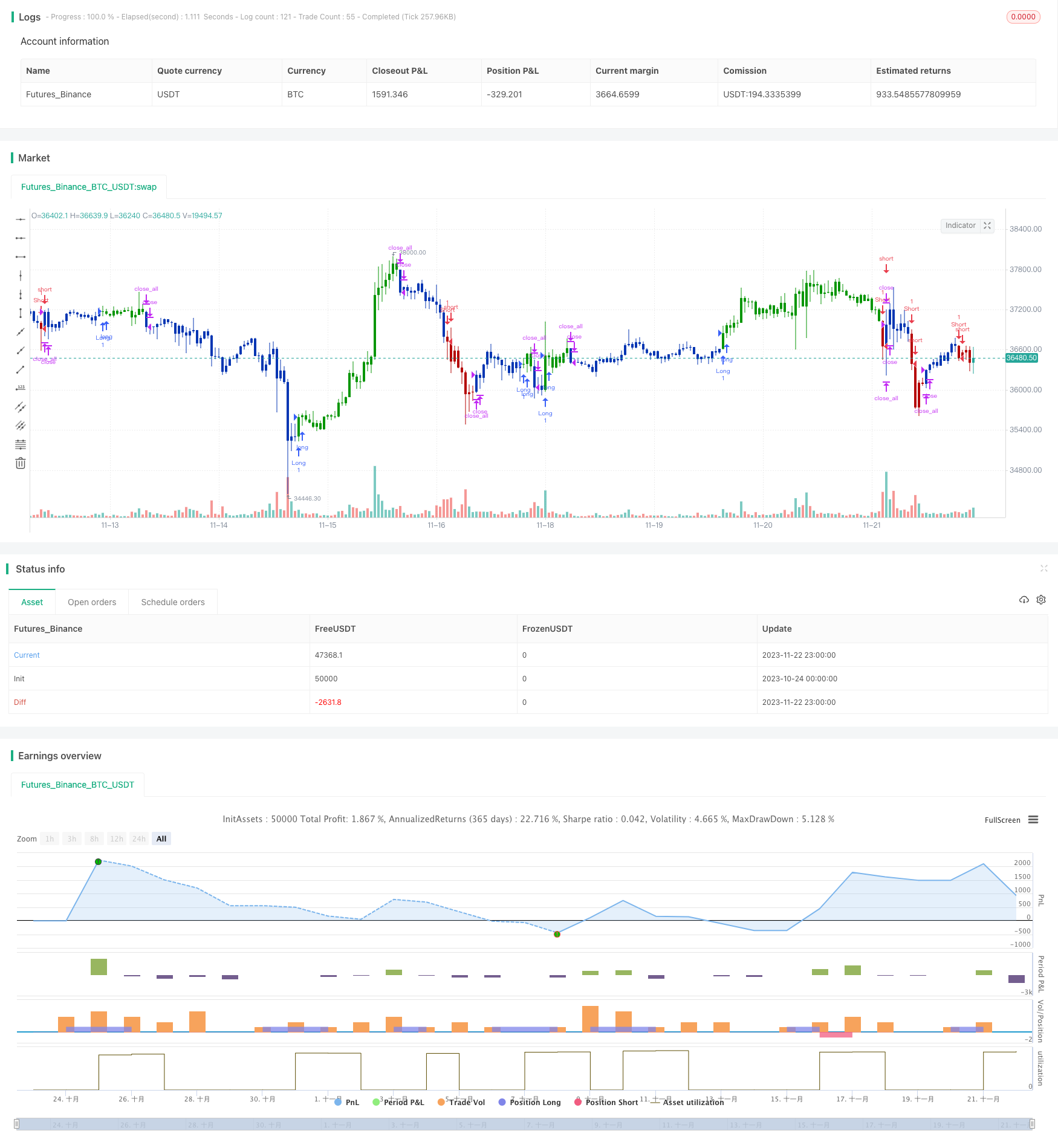
概述
该策略是一个利用双均线形态进行套利操作的策略。它结合了123形态反转和有限成交量元素(FVE)两个子策略,当两者同时发出买入或卖出信号时,进行套利操作。
策略原理
123形态反转
该子策略来源于Ulf Jensen的《我如何在期货市场上获利三倍》一书。它在以下条件发出信号:
- 当收盘价连续2日上涨,且9日慢stoch指标低于50时,做多;
- 当收盘价连续2日下跌,且9日快stoch指标高于50时,做空。
有限成交量元素(FVE)
FVE是一个纯粹的成交量指标。它根据价格的涨跌幅度和成交量的大小,判断资金是流入还是流出。
当最近两个bar的FVE指标同时上涨或下跌时发出信号。
优势分析
该策略结合两种指标判断市场趋势和资金流向,可以有效避免错误信号。且两个子策略都具有一定的反转特征,因此可以进行套利操作以获利。
另外,双均线形态出现时,代表短期和中期趋势一致,因此具有较强的稳定性。
风险分析
该策略依赖均线形态,当市场震荡时,容易出现错误信号导致亏损。此外,反转失败是常见的风险。
可以通过适当调整参数使策略更为稳健,也可以设置止损来控制风险。
优化方向
可以测试更多种类的均线指标寻找最佳匹配。也可以引入其他辅助判断指标,如强弱指标、波动率指标等来避免错误信号。
此外,可以研究如何根据市场状态动态调整参数,使策略更具适应性。也可以探索机器学习和神经网络算法以实现参数自适应。
总结
该双均线套利策略整合两种反转思路指标进行判断,可以一定程度上规避风险。但由于依赖均线形态,仍需进一步优化以使策略更稳健。总的来说,该策略为短线套利交易提供了一个基础框架,值得进一步研究。
策略源码
/*backtest
start: 2023-10-24 00:00:00
end: 2023-11-23 00:00:00
period: 1h
basePeriod: 15m
exchanges: [{"eid":"Futures_Binance","currency":"BTC_USDT"}]
*/
//@version=4
////////////////////////////////////////////////////////////
// Copyright by HPotter v1.0 25/08/2020
// This is combo strategies for get a cumulative signal.
//
// First strategy
// This System was created from the Book "How I Tripled My Money In The
// Futures Market" by Ulf Jensen, Page 183. This is reverse type of strategies.
// The strategy buys at market, if close price is higher than the previous close
// during 2 days and the meaning of 9-days Stochastic Slow Oscillator is lower than 50.
// The strategy sells at market, if close price is lower than the previous close price
// during 2 days and the meaning of 9-days Stochastic Fast Oscillator is higher than 50.
//
// Second strategy
// The FVE is a pure volume indicator. Unlike most of the other indicators
// (except OBV), price change doesn?t come into the equation for the FVE (price
// is not multiplied by volume), but is only used to determine whether money is
// flowing in or out of the stock. This is contrary to the current trend in the
// design of modern money flow indicators. The author decided against a price-volume
// indicator for the following reasons:
// - A pure volume indicator has more power to contradict.
// - The number of buyers or sellers (which is assessed by volume) will be the same,
// regardless of the price fluctuation.
// - Price-volume indicators tend to spike excessively at breakouts or breakdowns.
//
// WARNING:
// - For purpose educate only
// - This script to change bars colors.
////////////////////////////////////////////////////////////
Reversal123(Length, KSmoothing, DLength, Level) =>
vFast = sma(stoch(close, high, low, Length), KSmoothing)
vSlow = sma(vFast, DLength)
pos = 0.0
pos := iff(close[2] < close[1] and close > close[1] and vFast < vSlow and vFast > Level, 1,
iff(close[2] > close[1] and close < close[1] and vFast > vSlow and vFast < Level, -1, nz(pos[1], 0)))
pos
FVE(Period,Factor) =>
pos = 0
nRes = 0.0
xhl2 = hl2
xhlc3 = hlc3
xClose = close
xVolume = volume
xSMAV = sma(xVolume, Period)
nMF = xClose - xhl2 + xhlc3 - xhlc3[1]
nVlm = iff(nMF > Factor * xClose / 100, xVolume,
iff(nMF < -Factor * xClose / 100, -xVolume, 0))
nRes := nz(nRes[1],0) + ((nVlm / xSMAV) / Period) * 100
pos := iff(nRes > nRes[1] and nRes > nRes[2], 1,
iff(nRes < nRes[1] and nRes < nRes[2], -1, nz(pos[1], 0)))
pos
strategy(title="Combo Backtest 123 Reversal & Finite Volume Elements (FVE)", shorttitle="Combo", overlay = true)
Length = input(15, minval=1)
KSmoothing = input(1, minval=1)
DLength = input(3, minval=1)
Level = input(50, minval=1)
//-------------------------
Period = input(18, minval=1)
Factor = input(0.6, minval=0.1)
reverse = input(false, title="Trade reverse")
posReversal123 = Reversal123(Length, KSmoothing, DLength, Level)
posFVE = FVE(Period,Factor)
pos = iff(posReversal123 == 1 and posFVE == 1 , 1,
iff(posReversal123 == -1 and posFVE == -1, -1, 0))
possig = iff(reverse and pos == 1, -1,
iff(reverse and pos == -1 , 1, pos))
if (possig == 1)
strategy.entry("Long", strategy.long)
if (possig == -1)
strategy.entry("Short", strategy.short)
if (possig == 0)
strategy.close_all()
barcolor(possig == -1 ? #b50404: possig == 1 ? #079605 : #0536b3 )